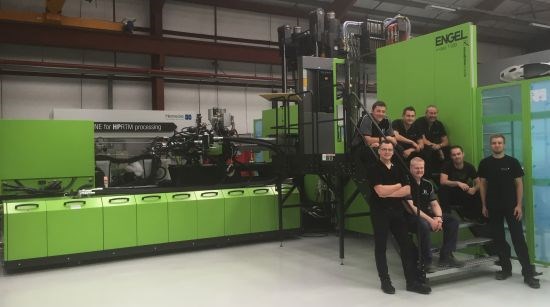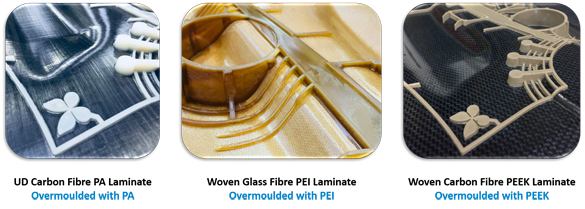Overmolding as enabler for composites, aerospace to automotive
CCP Gransden can make 50 to 100,000 parts/yr economically viable using PEEK, PPS, PEI or PA.
CCP Gransden (Belfast, Northern Ireland) has been in the Advanced Engineering sector for over a century. Forty of those years have been specifically in the manufacture of advanced composites, beginning with large glass fiber-reinforced structures (2-3m diameter) for harsh environments. In 2012, the company identified opportunities for growth through the use of new advanced technologies and the manufacture of lightweight thermoplastic composites. “There was a lot of interest from both the aerospace and automotive markets,” says Scott King, Strategic Partnership Manager. “We saw a fit where we could offer improved performance to our customers using new innovative processes.”
One of the opportunities which CCP Gransden started to explore was overmolding. It worked with Engel (Schwertberg, Austria) through the local office Engel UK Ltd. (Warwick) to install vduo 1100 workcell and develop this into a state of the art high-volume advanced composite production system. The Engel workcell combines thermal-press forming and injection molding to achieve single-stage composite overmolding.

CCP Gransden uses an Engel vduo 1100 work cell which combines compression and injection molding into a one-shot process for overmolded composites.
SOURCE: CCP Gransden.
“The process begins with a reinforced thermoplastic blank called an organosheet,” says King, “which is heated in our unique oven.” Unique? He explains that the infrared oven has some design features integrated into it to increase process control and heating speed. “The heated blank is then transferred to the press tool using a high speed multi-axis robot. When the press closes to complete the thermal press forming process, the injection molding unit simultaneously injects a shot of high-performance molten thermoplastic.” This thermoplastic is often filled with chopped fiber. “This is a super-fast, one-stage process and offers cycle times under two minutes, depending on the part size and complexity,” says King.
Demonstration part is CF/PPS organosheet overmolded with 20% CF PPS compound.
SOURCE: CCP Gransden.
He notes there was a challenge initially, because the aerospace industry wanted to work with polyetherimide (PEI), polyphenylene sulfide (PPS) and polyetheretherketone (PEEK), while automotive wanted polyamide (PA, nylon). “So we began working with PEEK and polyetherketoneketone (PEKK), developing a significant expertise.” He says it only took one day for the company to move from PEEK to PA. “PEEK has a narrow processing window, to get good flow from the injector into the mold tool. The appropriate heat distribution over the tool is very critical.” After succeeding in this, processing PA seemed relatively simple.
“Each component manufactured in our cell has full process traceability thanks to our data logging capability,” he points out. “This means that we can effectively give each component a birth certificate to provide confidence to our clients that each component is manufactured via a standardized, repeatable process per AS9100 standards.”
King says this overmolding technology has provided CCP Gransden with significant benefits in the design and manufacture of high performance components:
- High strength, rigidity and shape of the press formed thermoplastic laminates.
- Integration of injection-molded reinforcement structures to enhance rigidity while delivering functional features and assembly attachments.
- Ability to produce lightweight, complex components.
- Impressively low cycle times, typically under 2 minutes per part.
- Ability to use a greater range of materials.
- Excellent bonding, which creates interfaces considered as one structure.
- Substantial reduction in tooling and process steps.
- Aesthetically-pleasing thermal weld.
Single-stage process
Many of these benefits are made possible by the single-stage process. “Previously, a two-stage process has been employed,” King explains, “where the thermal press forming process is completed in one tool. Then, a secondary operation is required to perform the injection molding cycle in a second mold.”
He claims the single-stage process gives a far better bond between the overmolding and base laminate. “Forming at where both materials are at semi-molten stage, you then blend them, which results in interdiffusion,” King says. “So you get better mechanical properties. Otherwise, it’s a melt-melt interface. This also produces an aesthetically pleasing join/overmold, with no spillage at the side and clean, sharp edges. Though this may not affect the part strength, it certainly would convey we do not have control and precision. But, of course, we do.” He adds that CCP Gransden can also use the same polymer matrix in both the thermoplastic laminates and the overmold, something not feasible in a two-stage process.
What about reported difficulties in overmolding PEEK onto a PEEK base laminate even in single-stage processes? “The specifics of how we achieve this is proprietary,” King replies, “but temperature control and the speed of operation are critical.”
The demonstration part above made with carbon fiber/PPS is shown here made with unidirectional CF/PA, woven glass fabric/PEI and woven carbon fabric/PEEK. A glass/PA version has also been produced. SOURCE: CCP Gransden.
Economic viability
What about the perception that overmolding is very expensive, with high tooling costs? “Some perceive that part costs will run into the thousands,” King says, “but that’s not how we see it. It can be cost-effective, especially if you look at the complete life cycle because it removes assembly stages. You no longer need multiple different materials and inserts, but instead deliver just one integrated part to the line. We are also looking to further reduce the cost of overmolding. For example, many think the tooling will be £85,000-100,000 ($120,000-140,000) or more, but we have been able to utilize tooling that costs as little as £10,000-15,000 ($14,000-21,000) to produce complex, overmolded components. So we have made a lot of progress here.”
He points out that part volume and cost implications are key factors taken into account during tooling material selection and design, for example, whether or not to use ejector pins. “These can add in a lot of extra cost,” says King. “You can do a lot to tailor solutions to a client’s needs. We pride ourselves in this competence and also the ability to work quickly for our clients.”
“We can make 1,000-1,500 parts per 24-hr shift,” he says, noting that the CF/PPS demonstration part was pressed/molded in 60 seconds. “We could probably even reduce that further.”
He also stresses cost-effective design and development. “It took us 12 weeks from design to finished component including tooling, process and materials development. We wanted to demonstrate that getting from a concept to a commercial product doesn’t have to take years. It can be done in weeks.”
Related Content
Natural fiber composites: Growing to fit sustainability needs
Led by global and industry-wide sustainability goals, commercial interest in flax and hemp fiber-reinforced composites grows into higher-performance, higher-volume applications.
Read MoreCombining multifunctional thermoplastic composites, additive manufacturing for next-gen airframe structures
The DOMMINIO project combines AFP with 3D printed gyroid cores, embedded SHM sensors and smart materials for induction-driven disassembly of parts at end of life.
Read MoreBio-based acrylonitrile for carbon fiber manufacture
The quest for a sustainable source of acrylonitrile for carbon fiber manufacture has made the leap from the lab to the market.
Read MoreRecycling end-of-life composite parts: New methods, markets
From infrastructure solutions to consumer products, Polish recycler Anmet and Netherlands-based researchers are developing new methods for repurposing wind turbine blades and other composite parts.
Read MoreRead Next
“Structured air” TPS safeguards composite structures
Powered by an 85% air/15% pure polyimide aerogel, Blueshift’s novel material system protects structures during transient thermal events from -200°C to beyond 2400°C for rockets, battery boxes and more.
Read MoreVIDEO: High-volume processing for fiberglass components
Cannon Ergos, a company specializing in high-ton presses and equipment for composites fabrication and plastics processing, displayed automotive and industrial components at CAMX 2024.
Read MoreDeveloping bonded composite repair for ships, offshore units
Bureau Veritas and industry partners issue guidelines and pave the way for certification via StrengthBond Offshore project.
Read More
















.jpg;maxWidth=300;quality=90)







